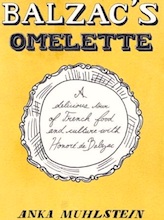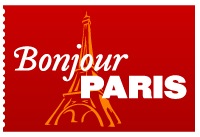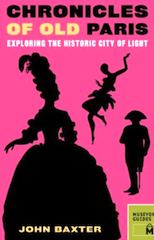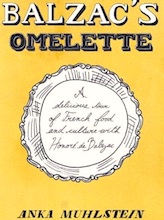Book Review
Balzac’s Omelette: A Delicious Tour of French Food and Culture with Honoré de Balzac
Published October 2011; Hardcover, 256 pages
Publisher: Other Press
Language: English
By Anne McCarthy
It is difficult to imagine a Paris without restaurants, but prior to the French Revolution, such was the case. Paris-born French author Anka Muhlstein takes the reader on a journey through Paris during the culinary days of yore, in her latest book, Balzac’s Omelette: A Delicious Tour of French Food and Culture with Honoré de Balzac. The book delves into the world of
Honoré de Balzac through an epicurean lens, at a time when restaurants were slowly emerging.
Balzac was notorious for his love of fine food, as evidenced by the photograph of him in Muhlstein’s book, which shows a rather stout Balzac. Muhlstein, a native Parisian and biographer extraordinaire has covered the lives of other famous figures from
Queen Victoria to
James Mayer de Rothschild. Her portrayal of Balzac shows the biographer’s prowess; she offers a detailed account of the life of Balzac, along with a fascinating overview of 19th-century Paris in which he lived. Other elements of the book, like the detailed timeline, city map, lithographs, photographs, artwork and even a photo of an antique coffee machine from Balzac’s time, thrust the reader into a Paris of the past.
The reader learns that Balzac was not always a writer. The first part of his life was dedicated to the study and practice of law. After becoming fed up with the monotony of the law office, he abandoned those pursuits and went on to become the playwright and novelist as we know him today. Balzac not only contributed to the creative output of his era, but he remains a founding father of the “realism” movement in French literature. His characters were flawed and “real” in every sense of the word. Balzac is said to have influenced other French writers such as
Marcel Proust,
Gustave Flaubert and
Émile Zola. Muhlstein touches on Zola and Flaubert and their literary contributions towards gastronomic writings as well.
Balzac was known for his social commentary, as evidenced in his most famous work,
La Comédie Humaine, a collection of short stories which offered an overview of French life after the fall of Napoleon in 1815. He wanted to create a work that examines “all aspects of society.”
One of the major aspects of society and Balzac’s own life was food. In the 19th century, Paris ascended to the gastronomic capital as we know it today. Food emerged in the forefront of French culture, on par with art, literature and music. Balzac was one of the first writers to explore the “phenomenon” of food in France. His interest in food is evidenced in his long narrative scenes which frequently occur in the dining room, along with other culinary references that are found in his works. The role of food in literature, Muhlstein explains, is a prominent fixture and method of characterization. Dickens used food, or lack thereof, to symbolize poverty in books like Oliver Twist.
George Sand explored the pleasure given by food in the depiction of carefree meals in the country.
Balzac was known to be fickle about his food. He believed in fine foods and he also advocated fasting from them. During intense writing periods, he fasted from the foods he loved so much, like sardines, oysters, Comice pears and the French favorite, duck. Balzac endured periods of fasting because he wanted to avoid “wearying the brain with digestion.” He believed that eating might interfere with his creativity. Like many great artists, Balzac’s eccentricities produced remarkable works such as Father Gorio and Lost Illustrations.
Balzac abhorred gluttony and his love of food stemmed from a place of epicurean adulation, rather than mindless eating. Muhlstein recounts a story in which Balzac dragged his friend
Leon Gozlan along on a fervent hunt for macaroni pasta, which, at the time, was at the height of its fashion. Macaroni pasta may no longer be de rigueur in current Parisian culinary circles, but the pursuit of good food is always in fashion.
Any French native, Francophile or college student worth their salt knows the value of a good cup of coffee. And Balzac was no exception. It could be said that he lived for coffee, referring to the drink as his “drug” that helped him to write. What alcohol was to
Amy Winehouse (she created her smash hit single Rehab from the incessant suggestions that she enter an alcohol addiction treatment facility), coffee was to Balzac. In his later years, he drank coffee by the bucket, according to Muhlstein. As imagined, this habit caused Balzac to suffer from eye twitches and stomach cramps. It is speculated that his excessive coffee consumption and subsequent manic periods of writing (often for 18 hours at a time) contributed to his early death in 1850 at the age of 51.
In December 2011 the polemic British author
Christopher Hitchens passed away at the age of 62 after losing his battle to esophageal cancer. Hitchens, like Balzac, was a great writer. And Hitchens, like Balzac, operated on a “no holds barred” manner of socially aware writing, as inferred by the titling of his infamous
Vanity Fair magazine essay,
Why Women Aren’t Funny, and his nonfiction book, God is Not Great: How Religion Poisons Everything. Like Balzac, Hitchens was a slave to consumption. Balzac had rich food and coffee, while Hitchens preferred alcohol and cigarettes. Muhlstein’s account of Balzac leaves the reader with a better understanding of art and the means it can sometimes take to produce it. For Balzac, coffee…
 Book Review
Book Review
Balzac’s Omelette: A Delicious Tour of French Food and Culture with Honoré de Balzac
Published October 2011; Hardcover, 256 pages
Publisher: Other Press
Language: English
By Anne McCarthy
It is difficult to imagine a Paris without restaurants, but prior to the French Revolution, such was the case. Paris-born French author Anka Muhlstein takes the reader on a journey through Paris during the culinary days of yore, in her latest book, Balzac’s Omelette: A Delicious Tour of French Food and Culture with Honoré de Balzac. The book delves into the world of Honoré de Balzac through an epicurean lens, at a time when restaurants were slowly emerging.
Balzac was notorious for his love of fine food, as evidenced by the photograph of him in Muhlstein’s book, which shows a rather stout Balzac. Muhlstein, a native Parisian and biographer extraordinaire has covered the lives of other famous figures from Queen Victoria to James Mayer de Rothschild. Her portrayal of Balzac shows the biographer’s prowess; she offers a detailed account of the life of Balzac, along with a fascinating overview of 19th-century Paris in which he lived. Other elements of the book, like the detailed timeline, city map, lithographs, photographs, artwork and even a photo of an antique coffee machine from Balzac’s time, thrust the reader into a Paris of the past.
The reader learns that Balzac was not always a writer. The first part of his life was dedicated to the study and practice of law. After becoming fed up with the monotony of the law office, he abandoned those pursuits and went on to become the playwright and novelist as we know him today. Balzac not only contributed to the creative output of his era, but he remains a founding father of the “realism” movement in French literature. His characters were flawed and “real” in every sense of the word. Balzac is said to have influenced other French writers such as Marcel Proust, Gustave Flaubert and Émile Zola. Muhlstein touches on Zola and Flaubert and their literary contributions towards gastronomic writings as well.
Balzac was known for his social commentary, as evidenced in his most famous work, La Comédie Humaine, a collection of short stories which offered an overview of French life after the fall of Napoleon in 1815. He wanted to create a work that examines “all aspects of society.”
One of the major aspects of society and Balzac’s own life was food. In the 19th century, Paris ascended to the gastronomic capital as we know it today. Food emerged in the forefront of French culture, on par with art, literature and music. Balzac was one of the first writers to explore the “phenomenon” of food in France. His interest in food is evidenced in his long narrative scenes which frequently occur in the dining room, along with other culinary references that are found in his works. The role of food in literature, Muhlstein explains, is a prominent fixture and method of characterization. Dickens used food, or lack thereof, to symbolize poverty in books like Oliver Twist. George Sand explored the pleasure given by food in the depiction of carefree meals in the country.
Balzac was known to be fickle about his food. He believed in fine foods and he also advocated fasting from them. During intense writing periods, he fasted from the foods he loved so much, like sardines, oysters, Comice pears and the French favorite, duck. Balzac endured periods of fasting because he wanted to avoid “wearying the brain with digestion.” He believed that eating might interfere with his creativity. Like many great artists, Balzac’s eccentricities produced remarkable works such as Father Gorio and Lost Illustrations.
Balzac abhorred gluttony and his love of food stemmed from a place of epicurean adulation, rather than mindless eating. Muhlstein recounts a story in which Balzac dragged his friend Leon Gozlan along on a fervent hunt for macaroni pasta, which, at the time, was at the height of its fashion. Macaroni pasta may no longer be de rigueur in current Parisian culinary circles, but the pursuit of good food is always in fashion.
Any French native, Francophile or college student worth their salt knows the value of a good cup of coffee. And Balzac was no exception. It could be said that he lived for coffee, referring to the drink as his “drug” that helped him to write. What alcohol was to Amy Winehouse (she created her smash hit single Rehab from the incessant suggestions that she enter an alcohol addiction treatment facility), coffee was to Balzac. In his later years, he drank coffee by the bucket, according to Muhlstein. As imagined, this habit caused Balzac to suffer from eye twitches and stomach cramps. It is speculated that his excessive coffee consumption and subsequent manic periods of writing (often for 18 hours at a time) contributed to his early death in 1850 at the age of 51.
In December 2011 the polemic British author Christopher Hitchens passed away at the age of 62 after losing his battle to esophageal cancer. Hitchens, like Balzac, was a great writer. And Hitchens, like Balzac, operated on a “no holds barred” manner of socially aware writing, as inferred by the titling of his infamous Vanity Fair magazine essay, Why Women Aren’t Funny, and his nonfiction book, God is Not Great: How Religion Poisons Everything. Like Balzac, Hitchens was a slave to consumption. Balzac had rich food and coffee, while Hitchens preferred alcohol and cigarettes. Muhlstein’s account of Balzac leaves the reader with a better understanding of art and the means it can sometimes take to produce it. For Balzac, coffee and food were his fuel—a fuel that created great works of literature which remain pertinent today.

Balzac was the quintessential Frenchman: he lived each day to the fullest and enjoyed every minute of it. The reader will be reminded of this outlook, and perhaps incorporate it into their own life for this New Year.
Anne McCarthy is an American writer who lived in Paris and she’s writing a humor memoir about her adventures in Paris. Please click on her name to read other stories by Anne published by BonjourParis.
More editorial reviews of Balzac’s Omelette by Anka Muhlstein:
“Fabulous . . . worth nibbling on, as prelude or accompaniment to the pièce de résistance, ‘The Human Comedy.’” —New York Times Book Review
“Anka Muhlstein folds wit into scholarship as easily as breaking an egg. Let us now join hands and say grace for her brilliant and beguiling
Balzac’s Omelette.” —Patricia Volk, author of
Stuffed and
To My Dearest Friends“Balzac’s Omelette . . . is a charming and modest little book.” —New York Review of Books
“Muhlstein uses Balzac as a guide to the French culinary scene of the 19th century in a literary analysis that is original, delectable and entirely readable.” —The Washington Post
“This scholarly yet escapist book explores how French cuisine influenced Honoré de Balzac’s genius… irresistible.” —Daily Beast
“This effervescent volume celebrates Balzac’s use of gastronomy as a literary device and social critique.” —
The New Yorker“The story of post-Revolution food in Paris and the rise of food as a literary metaphor, as told through Balzac’s work…Not just for French lit majors—honest.” —France Magazine

Subscribe for FREE weekly newsletters with subscriber-only content.
BonjourParis has been a leading France travel and French lifestyle site since 1995.
Readers’ Favorites: Top 100 Books, imports & more at our Amazon store
We daily update our selections, including the newest available with an Amazon.com pre-release discount of 30% or more. Learn more about Paris and France present and past by starting at the back of the Nonfiction: Paris & France section, then work backwards page by page in sections that interest you.
Discover Balzac’s Paris as it was….please click on an image for details.




Support our site by clicking on this banner for all your Amazon.com browsing. Merci!

 Book Review
Book Review





